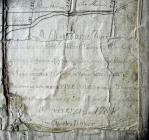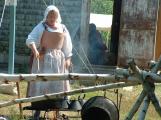14
This small Island in Remsheg Harbour is called Oyster Island. Today its a great spot for nesting Great Blue Herons. Around the beginning of the 20th Century it became the north end support, for the relatively long Livingstone Bridge. It is quite small, however it shows up on early charts of the Harbour, done prior to 1840. There are many oysters found near the Island but perhaps the inspiration for the name came from the Loyalists.One of the last Islands the Loyalist would see when leaving New York Harbour is one called Oyster Island.
15
Herons on Oyster Island in Wallace Harbour15 August 2012
Remsheg Harbour now Wallace Harbour
 Credits:
Credits:David Dewar
16
Dotten Cemetery, from Highway and Loyalist Monument in Fanningboro.15 August 2012
Fanningboro, Cumberland County
 Credits:
Credits:Jim Reeves
18
After the Refugees from New York landed at Fort Cumberland the British Government sent Charles Baker of Amherst, to survey the proposed Loyalist settlement.He with two chainmen surveyed first the 200 acre land grants in Remsheg and Westchester and then later carried on to the townsite of Fanningboro19
Part of the map of Fanningboro, surveyed by Charles Baker in 1784. Document shows statistics.18th Century, Circa 1784
Remsheg
 Credits:
Credits:Marion Dotten
Zella Perry
20
Trees and forest to the shore, a valuable resource, when the first refugees arrived in 1783-178418th Century, Circa 1783
Remsheg Harbour now Wallace Harbour
 Credits:
Credits:David Dewar
21
Loyalist refugees cooked their food outside while establishing shelter and clearing land.18th Century, Circa 1783
Forest Trail between Fort Cumberland and Remsheg
 Credits:
Credits:Charlotte Moody
22
Original Dotten home, built by James Dotten to replace his log cabin constructed after arriving 178415 August 2012
Fanningboro, Cumberland County
 Credits:
Credits:Jim Reeves
